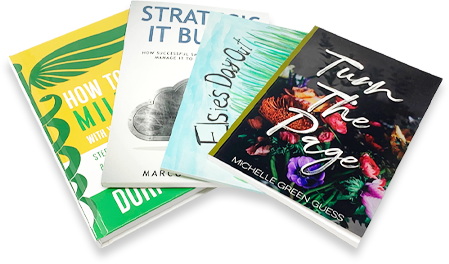Content Menu
● Leading Book Printing Companies in America
>> Quebecor World
>> R.R. Donnelley & Sons
>> Maple-Vail Book Manufacturing
>> Edwards Brothers
>> Quad/Graphics
>> LSC Communications
● Innovative Printing Technologies and Services
>> Digital and Offset Printing
>> Binding and Finishing Techniques
>> Integrated Services
● Market Trends Shaping the Book Printing Industry in America
>> Growth and Market Size
>> Sustainability Initiatives
>> Short-Run and Print-on-Demand Services
>> Impact of Tariffs and Supply Chain Dynamics
>> Digital Integration and AI
● Specialized Publishers with Printing Capabilities
>> Penguin Random House (Bertelsmann)
>> Scholastic Corporation
>> HarperCollins Publishers
>> Simon & Schuster
>> Hachette Book Group and Macmillan Publishers
● Conclusion
● FAQ
>> 1. What printing technologies do the top printed books manufacturers in America use?
>> 2. Which companies specialize in short-run and print-on-demand book printing?
>> 3. How is sustainability addressed in the American book printing industry?
>> 4. How do tariffs affect book printing in America?
>> 5. Can authors get both hardcover and softcover books printed by these manufacturers?
The book printing industry in America is a dynamic and essential sector that supports authors, publishers, and readers through the production of high-quality printed books. With the rise of digital technology and evolving market demands, the top printed books manufacturers in America have adapted by integrating advanced printing techniques, sustainable practices, and comprehensive service offerings. This article provides an in-depth overview of the leading book printing companies in America, their specialties, technological innovations, and the market trends shaping the industry.

Leading Book Printing Companies in America
Quebecor World
Quebecor World is recognized as the largest commercial printer and image-management company in North America. Printing over one billion books annually, Quebecor World serves a diverse range of publishers with both hardcover and softcover book options. Their cutting-edge facilities and vast experience enable them to maintain a dominant position in the book manufacturing industry.
R.R. Donnelley & Sons
Founded in 1864, R.R. Donnelley is one of the oldest and most trusted names in book printing. With manufacturing facilities across the United States and Mexico, they offer comprehensive services including web offset, sheetfed offset, and digital printing. Their capabilities extend to hardcover and softcover book production, custom publishing, on-demand printing, packaging design, and digital conversion for online distribution.
Maple-Vail Book Manufacturing
Maple-Vail is a full-service book manufacturer providing prepress, digital scanning, proofing, and various binding options such as smyth-sewn and casebound. They also offer automated cartoning, drop shipping, and real-time job status tracking, making them a preferred choice for publishers requiring precision and efficiency in short to medium print runs.
Edwards Brothers
With operations in Michigan, North Carolina, and Kansas, Edwards Brothers specializes in ultra-short and medium print runs of high-quality books and journals. Their services include prepress, binding, and a wide selection of paper and cover stocks, catering primarily to educational and scholarly publications.
Quad/Graphics
Established in 1971 and headquartered in Wisconsin, Quad/Graphics is a leading book printing company offering a wide range of services from design and production to distribution. With over 50 years of experience, they are known for high-quality book printing solutions and innovative approaches tailored to publishers' needs.
LSC Communications
LSC Communications, based in Chicago, Illinois, is a global leader in book printing serving publishers of all sizes across North America. They focus on innovation and technology, providing prepress, print production, warehousing, and distribution services to meet evolving client demands.
Innovative Printing Technologies and Services
Digital and Offset Printing
The top printed books manufacturers in America utilize a combination of offset and digital printing technologies. Offset printing remains the preferred method for large print runs due to its cost efficiency and high-quality output. Digital printing, on the other hand, is ideal for short-run and print-on-demand (POD) services, offering flexibility and faster turnaround times.
Binding and Finishing Techniques
Manufacturers provide a variety of binding options including smyth-sewn, casebound (hardcover), PUR softcover, and adhesive binding. Advanced finishing techniques such as foil stamping, embossing, sprayed edges, and thermo-sensitive glitter add value and aesthetic appeal to books.
Integrated Services
Many manufacturers offer end-to-end solutions including prepress, printing, binding, packaging, warehousing, and distribution. This integrated approach helps publishers streamline production, reduce costs, and improve supply chain efficiency.

Market Trends Shaping the Book Printing Industry in America
Growth and Market Size
North America holds a significant share of the global book printing market, estimated to exceed 28% in 2024. The U.S. printing industry alone is projected to surpass $80 billion by 2025, with digital printing revenues expected to exceed $25 billion. This growth is driven by technological advancements, increasing demand for sustainable printing, and the rise of self-publishing.
Sustainability Initiatives
Environmental concerns are pushing manufacturers to adopt eco-friendly practices such as using recycled paper, soy-based inks, and energy-efficient machinery. Sustainable packaging and waste reduction strategies are becoming standard in the industry.
Short-Run and Print-on-Demand Services
The demand for short-run printing and POD services continues to rise, particularly among self-published authors and educational publishers. These services allow for smaller print quantities, reduced inventory costs, and rapid response to market demand.
Impact of Tariffs and Supply Chain Dynamics
Import tariffs on paper and printing materials have influenced production costs, encouraging a shift towards domestic sourcing. While this supports local economies, it also presents challenges in cost management and supply chain stability.
Digital Integration and AI
The integration of AI and machine learning in production processes is enhancing efficiency, quality control, and predictive maintenance. Data-driven inventory management and dynamic list management optimize print runs and reduce waste.
Specialized Publishers with Printing Capabilities
Penguin Random House (Bertelsmann)
As a major media conglomerate, Bertelsmann's Penguin Random House operates extensive printing and distribution networks, supporting a diverse range of book genres and formats.
Scholastic Corporation
Specializing in children's books and educational materials, Scholastic has been a leader in book printing for over a century, focusing on innovative educational content and wide distribution.
HarperCollins Publishers
A subsidiary of News Corp, HarperCollins offers comprehensive printing and distribution services, catering to traditional publishers and self-published authors alike.
Simon & Schuster
With nearly 100 years of experience, Simon & Schuster provides diverse printing services, ensuring quality and timely production for a broad spectrum of authors.
Hachette Book Group and Macmillan Publishers
Both companies are prominent general trade publishers with extensive printing capabilities, supporting a wide array of literary imprints and innovative book formats.
Conclusion
The top printed books manufacturers in America play a crucial role in the publishing ecosystem by combining traditional craftsmanship with innovative technology. Companies such as Quebecor World, R.R. Donnelley, Maple-Vail, and Quad/Graphics lead the market with comprehensive services that meet the needs of publishers, authors, and readers. The industry's growth is fueled by advances in digital printing, sustainable practices, and integrated production and distribution solutions. As the market continues to evolve, these manufacturers will remain essential partners in bringing quality printed books to the North American and global markets.

FAQ
1. What printing technologies do the top printed books manufacturers in America use?
They primarily use offset printing for large runs and digital printing for short-run and print-on-demand services, complemented by advanced binding and finishing techniques.
2. Which companies specialize in short-run and print-on-demand book printing?
Cushing-Malloy, Edwards Brothers, and Maple-Vail are notable for their expertise in short-run printing and POD services.
3. How is sustainability addressed in the American book printing industry?
Manufacturers adopt recycled paper, eco-friendly inks, and energy-efficient machinery to reduce environmental impact and meet customer demand for green products.
4. How do tariffs affect book printing in America?
Tariffs on imported paper and materials can increase production costs, encouraging domestic sourcing and potentially raising book prices.
5. Can authors get both hardcover and softcover books printed by these manufacturers?
Yes, most top manufacturers offer a wide range of binding options including hardcover, softcover, and specialty bindings.
































